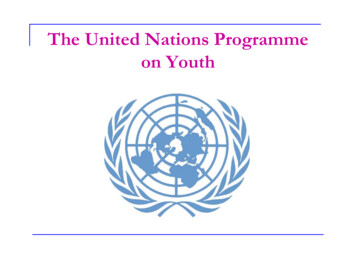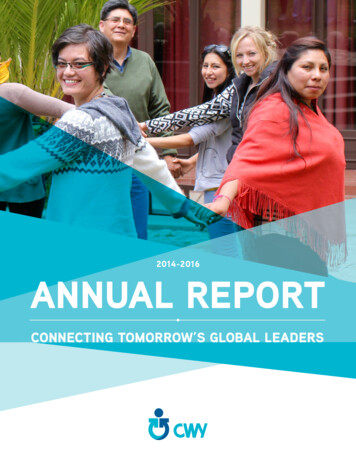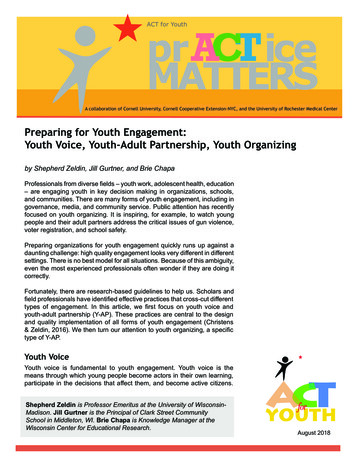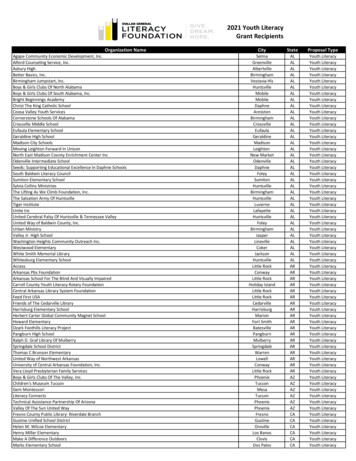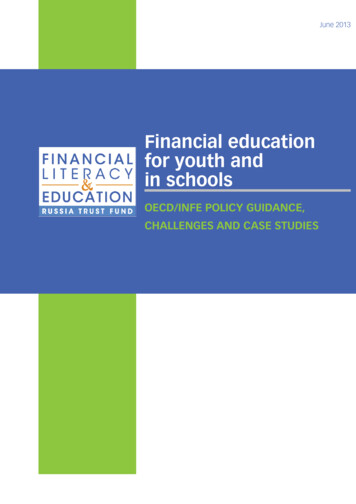
Transcription
June 2013Financial educationfor youth andin schoolsOECD/INFE pOlICy guIDaNCE,ChallENgEs aND CasE stuDIEs
FINANCIAL EDUCATION FOR YOUTH AND IN SCHOOLS:OECD/INFE POLICY GUIDANCE, CHALLENGES AND CASE STUDIES
FOREWORDThe post-crisis world has notably evidenced the needs for new individual skills, including financialliteracy. Younger generations will face increasing financial risks, will be confronted with moresophisticated financial products than did previous generations and they are now given access to financialservices and products at an ever younger age. However, these developments do not appear to bematched by an equivalent increase in their financial skills. Evidence from national and OECD/INFE surveysshows that younger generations have lower levels of financial literacy compared with those of theirparents, leading to potential new vulnerabilities. This mismatch potentially has important implications forexample in terms of responsible use of credit, adequacy of saving for retirement or even social andfinancial inclusion of future generations.Back in 2002, recognising the negative consequences of a lack of financial literacy, the OECDestablished a comprehensive project on financial education, under the aegis of the Committee onFinancial Markets and the Insurance and Private Pensions Committee. In 2008, the OECD InternationalNetwork on Financial Education (INFE) was created to outreach beyond the OECD Member countries andstrengthen information sharing, collect evidence, develop analytical work and related policy instruments.The OECD/INFE currently comprises more than 220 public institutions in 107 countries.With the support of the Russia/WB/OECD Trust Fund for Financial Literacy and Education, the OECDhas led the development and worldwide dissemination of the following three main types of products andtools: Broad and detailed reviews and inventories of effective financial education activities andpolicies worldwide, thanks to the wide membership and involvement of the OECD/INFE. Policy, analytical and comparative reports and research highlighting good practices and detailedcase studies on financial education and literacy across member countries. Criteria, standards, principles and guidelines as well as practical tools to facilitate and improvestrategic financial education effortsIn the framework of the Russia/WB/OECD Trust Fund for Financial Literacy and Education the OECDand its INFE have focused on financial education for youth and in schools. The first OECDRecommendation on Principles and Good Practices for Financial Education and Awareness in 2005already acknowledged that “financial education should start at school. People should be educated aboutfinancial matters as early as possible in their lives”. In the aftermath of the global financial crisis, financialliteracy has gained further international recognition as a critical life skill for individuals. In this respect, thetailored national strategies for financial education, which are developed in an increasing number ofcountries, almost systematically highlight the importance of financial education for youth and itsintroduction through schools.3
Indeed, surveys conducted through 2008-2011 show that at least twenty-one countries haveimplemented financial education programmes in schools. The surveys also point to the major challengespolicy makers and interested stakeholders and practitioners face when they seek to introduce financialeducation in schools from crowded curricula to the reluctance of educators and teachers and the lack ofsustainable resources.This publication aims at addressing these challenges by providing interested policy makers andstakeholders with international guidance, a set of complementary case studies of efficient practices incountries with diverse circumstances and education systems and a comparison of existing learningframeworks on financial education.Furthermore, the findings from this publication have been instrumental in the design of a financialliteracy assessment framework for the first ever financial literacy option in the OECD Programme forInternational Student Assessment (PISA) in 2012. The results of the PISA assessment will, in turn, providepolicy makers with essential empirical evidence on the levels of financial literacy in schools, which can beused to modify and expand existing practices as well as raise awareness of the importance of financialeducation in schools among all stakeholders.4
ACKNOWLEDGMENTSFinancial education in schools and for youth: OECD/INFE policy guidance challenges and case studiesis the result of a collaborative effort on the part of the OECD Secretariat and delegates to the OECDInternational Network on Financial Education (INFE). OECD/INFE delegates, and their counterparts withinnational administrations, helped in co-drafting substantial parts of the different chapters and providedimportant inputs into the drafting of the Guidelines on Financial Education in Schools. Though INFEdelegates are too numerous to mention by name, their contribution to this book is gratefullyacknowledged.The OECD would like to acknowledge in particular the contribution of the members of the INFEExpert Subgroup on Financial Education in Schools: Ms. Sue Lewis (Subgroup Leader), HM Treasury UnitedKingdom, Ms. Delia Rickard, Australian Securities and Investments Commission, Ms. Jane Rooney,Financial Consumer Agency of Canada, Ms. Ryouko Okazaki, Bank of Japan, Ms. Koid Swee Lian, CentralBank of Malaysia, Ms. Wilna Van Rossum, Dutch Ministry of Finance, Ms. Diana Crossan, Financial Literacyand Retirement Income Commission of New Zealand, Mr. Michal Nalepa, Polish Financial SupervisionAuthority, Mr. Andrei Markov, The World Bank, Ms. Olivia Davids, Financial Services Board of SouthAfrica. A special thank goes to Dr. Susan Watson, Education Consultant, who contributed to thepreparation of early drafts of parts of the publication.In the OECD Secretariat, the publication was prepared under the direction of Ms. Flore-Anne Messy,manager of the financial education project and Secretary of the INFE, and by Mr. Andrea Grifoni, PolicyAnalyst within the Financial Affairs Division.The research for this book was conducted as part of the programme of work of the OECD’s financialeducation project, which has been supported by the Russian/World Bank/OECD Trust Fund on FinancialLiteracy and Education.The publication is updated as of December 2012.5
Table of ContentsFOREWORD.3ACKNOWLEDGMENTS .5EXECUTIVE SUMMARY.9CHAPTER 1: INFE GUIDELINES FOR FINANCIAL EDUCATION IN SCHOOLS . 11I - Guidelines for financial education in schools .13II - Guidance on learning frameworks on financial education .22REFERENCES .27CHAPTER 2: FINANCIAL EDUCATION IN SCHOOLS: MAIN ISSUES AND SELECTED CASE STUDIES . 29I - Ways to promote and influence political willingness .31II - Effective approaches for the introduction of financial education into school curricula .38III - Training the teachers .43IV - Tools and pedagogic materials .47V - Role of private financing: importance and challenges .53VI - Evaluation of financial education programmes.59Notes .67REFERENCES .68CHAPTER 3: COMPARATIVE ANALYSIS OF SELECTED FINANCIAL EDUCATION LEARNING FRAMEWORKS71I - Scope and definition .73II - History of the development of existing frameworks .74III - Comparative analysis of content and pedagogical features .76IV - Existing financial education learning frameworks .83Notes .114REFERENCES .115ANNEX 3.A1: COMPARISON OF FINANCIAL EDUCATION LEARNING FRAMEWORKS IN SELECTEDCOUNTRIES .117ANNEX 3.A2: JAPAN: CONTENTS OF FINANCIAL EDUCATION BY AGE GROUP.123ANNEX 3.A3: THE NETHERLANDS: LEARNING TARGETS .135ANNEX 3.A4: NEW ZEALAND: POSSIBLE PROGRESSIONS OF LEARNING IN FINANCIAL LITERACY .1517
BoxesBox 1.1. Education systems’ involvement and support .15Box 1.2. Managing possible conflicts of interest relating to private financing and involvement infinancial education in schools .16Box 1.3. Criteria for identification and development of suitable resources on financial education .21Box 2.1. Timeline of the Brazilian evaluation of financial education in schools.61Box 3.1. Learning outcomes: the Australian and New Zealand examples for the same year .78TablesTable 3.1.Table 3.A1.1.Table 3.A1.2.Table 3.A1.3.Table 3.A1.4.Table 3.A2.1.Table 3.A3.1.Table 3.A3.2.Table 3.A3.3.Table 3.A3.4.Table 3.A3.5.Table 3.A3.6.Table 3.A3.7.Table 3.A3.8.Table 3.A4.1.Summary of learning frameworks on financial education .74Main characteristics of the frameworks .118Modalities of integration, assessment of outcomes and teaching practices .119Focus of the learning framework .121Dimensions included in financial education frameworks .122Learning framework goals for different age groups .124Primary education, middle section (age 8-10) .136Primary education, senior section (age 11-12) .137Special education (age 8-12) .138Preparatory secondary vocational education .139Senior general secondary education .141Senior general secondary education .143Preparatory secondary vocational education .145Senior secondary vocational education .148Learning outcomes .1528
EXECUTIVE SUMMARYThe term “financial education” in a school context is used to refer to the teaching of financialknowledge, understanding, skills, behaviours, attitudes and values which will enable students to makesavvy and effective financial decisions in their daily life and when they become adults. The outcome offinancial education is typically referred to as financial literacy or financial capability; for the sake of clarityand consistency with OECD and INFE terminology, in this publication the term “financial literacy” will beused except when referring to programmes or documents developed by countries that use differentterminology.National financial education strategies are increasingly involving the introduction of financialeducation into the school curriculum and the design and implementation of dedicated learningframeworks. The rationale for these new policy endeavours is multi-fold. First, while financial educationconcerns all ages, the education of younger generations on financial issues has become all the moreimportant since they will likely bear more financial risks and be faced with increasingly complex andsophisticated financial products than their parents. Second, the young have access to, and are beingoffered, financial services at ever earlier ages (through pocket money, cell phones, bank accounts, oreven credit cards). Yet, most recent surveys show worrying low levels of youth financial literacy and, inmany cases, significantly lower levels than older generations.Against this backdrop, including financial education in the formal school curriculum is recognised asone of the most efficient and fair ways to reach a whole generation on a broad scale. In addition, sincethe curriculum spans several years and can start as early as kindergarten, it is a unique means to inculcateand nurture a sound financial culture and behaviours amongst future adults. This is especially importantsince parents are unequally equipped to transmit to their children sound financial habits. Besides, asdemonstrated in other related education fields (such as health), young people are potentially gooddisseminators of new habits in the rest of the population.Yet the successful integration of financial education in school curricula can be challenging in manyrespects owing to a vast range of constraints, notably due to the fact that this is a new endeavour formost national administrations. These challenges include: lack of resources and time; overloaded curricula;insufficient expertise and know how; lack of high quality materials; the variety of stakeholders involved;and the lack of strong and sustainable political willingness, commitment and overall accountability.To address these challenges, the OECD International Network on Financial Education (INFE) decidedto develop research and guidelines to support the introduction and implementation of financialeducation in schools. This work has been conducted through a dedicated group of experts and built onpreliminary surveys conducted by the OECD Committee on Financial Markets in 2008, broad datacollection conducted through the OECD/INFE in 2008/2009 as well as analytical reports prepared by theOECD/INFE and the Secretariat.9
The publication is a compendium of this work and provides policy makers with internationalguidelines and case studies that present the most common challenges faced when trying to introducefinancial education in schools, and examples of countries that successfully overcame them.The first chapter is dedicated to the INFE Guidelines for Financial Education in Schools and toguidance on learning frameworks. It addresses the main steps for the introduction of financial educationinto schools and provides guidance on the development of a consistent and sustainable framework for itsintegration in school programmes. A successful introduction is better achieved through the setting ofquantifiable and appropriate goals, matched by flexible modalities of introduction and taking intoaccount resources and impact monitoring. This first section also explains the need to ensure a suitablelevel of involvement of public authorities and educational system, teachers and parents, and otherimportant stakeholders such as the private sector and NGOs. The Guidelines also highlight theimportance of the design and promotion of efficient means and incentives, methods for training teachers,the provision of adequate pedagogical material, evaluation of programmes and assessment of students.This chapter also includes guidance on the design of an appropriate learning framework for financialeducation, introducing topics that will be addressed more in detail through concrete examples in chapterthree. The focus of this section is on the purpose of the framework, the outcomes that students areexpected to develop, and on characteristics such as length of courses and specific content, pedagogicaltools, assessment of students’ results, monitoring and evaluation.The second chapter presents the main issues to be taken into consideration when introducingfinancial education in schools, and specific case studies showing the ways in which countries withdifferent institutional frameworks and uneven resources have addressed similar challenges. Theseselected relevant experiences support the implementation of the Guidelines and assist countries in thedesign and implementation of financial education programmes in schools.The topics of the case studies were identified by the OECD/INFE due to their importance and theirrelevance to policy makers. They include crucial elements such as political support to make financialeducation in school effective and sustainable over time, modalities of its introduction in schools, thetraining needed for teachers, the tools and pedagogical materials, the role of resources as well as theimportance of programme evaluation.Finally, chapter three provides a comparative analysis of existing learning frameworks for the formalschool sector in Australia, Brazil, England, Japan, Malaysia, The Netherlands, Northern Ireland, Scotland,South Africa and the United States. These are followed by detailed examples of learning outcomes andstandards for financial education, at the primary or secondary level. The chapter is articulated aroundtwo sections. The first one provides a comparative analysis of existing learning frameworks in relation totheir institutional and organisational development, their content and pedagogical features. The secondsection presents each of the frameworks in relation to their key characteristics.The experiences clarify the history of the development of the frameworks, putting them in a biggerpicture that includes national strategies for financial education and analysing the role played by keyinstitutions in initiating such programmes. They provide further details over the learning outcomes andthe topics and objectives addressed in different school grades.10
Chapter 1INFE GUIDELINES FOR FINANCIAL EDUCATION IN SCHOOLS*This chapter reproduces the INFE Guidelines for Financial Education in Schools. The Guidelinesare aimed at providing high-level non-binding international guidance to assist policymakers andinterested stakeholders in designing, introducing and implementing efficient financial educationprogrammes in schools. They are complemented by the Guidance on Learning Frameworks, definedas planned and coherent approaches to financial education in the formal school sector that defineoverall learning outcomes or standards for financial education.*The Guidelines and accompanying Guidance were developed and finalised through a comprehensiveconsultative process which involved a very wide range of stakeholders. The INFE elaborated and then approvedthe Guidelines and Guidance for further consultation in October 2010. The Guidelines and Guidance werereviewed and positively received by the Education Policy Committee in November 2010. In April 2011, theywere approved by the Committee on Financial Markets and Insurance and Private Pensions Committee (thetwo committees in charge of the financial education project) for public consultation, which took place inAugust-September 2011. The revised versions of the Guidelines and Guidance were approved by the INFE inOctober 2011; and the final versions as well as the present OECD/INFE guidelines were approved by the CMFand the IPPC on 1 March 2012.
I - Guidelines for financial education in schoolsFramework for the integration of financial education into school curriculaFinancial education in school programmes: an integral part of national coordinated strategiesFinancial education should ideally be integrated into the school curriculum as part of a co-ordinatednational strategy for financial education involving the wider community. School programmes should allowevery child in a country or jurisdiction to be exposed to this subject matter through the school curriculum.The introduction of financial education should be preceded by, and based on, an assessment and analysisof the status and level of financial education provided through existing curricula and the current level offinancial literacy of children and young people.The identification of a public leader or co-ordinating body at national level should ensure therelevance and long-term sustainability of the programme. This could be a Government Ministry, such asFinance or Education, a financial regulator, a central bank or a committee/council gathering several publicauthorities. Whichever co-ordinating body is chosen, it is essential to secure the involvement and supportof the Ministry of Education and of the education system at national, regional and local levels, preferablyfrom the beginning of the project (see also Box 1.1).Appropriate, tailored and quantifiable goalsThe overarching goals of the introduction of financial education in the school curriculum should beset through the nationally coordinated strategy and based on relevant education principles. Moredetailed objectives and outputs should preferably be established in dedicated learning frameworks1 onfinancial education. Such learning frameworks should preferably be endorsed by the public educationalauthorities.The content of the learning framework may vary according to national, regional or localcircumstances, the identification of particular talents, needs, aspirations and gaps, the structure andrequirements of the education system, and cultural or religious considerations, as well as the approachadopted for the introduction of financial education in schools. In this respect, in some countries orjurisdictions, learning frameworks on financial education may need to be developed at regional or locallevel.Learning frameworks on financial education should ideally encompass knowledge andunderstanding; skills and behaviours; as well as attitudes and values. These may also encompassentrepreneurial skills. In general, learning frameworks on financial education in schools provide someguidance either to schools and teachers or to local authorities on: Learning outcomes Topic/content of financial education classes which can include, according to school age/grade: Money and transactions;1See also the following section: II - Guidance on learning frameworks on financial education.13
Planning and managing finances; Risk and rewards; and, Financial landscape. Pedagogical approaches and methods Resources: Number of hours per week and/or per year depending on school grade; Time span in the curriculum. Assessment and monitoring criteriaFlexible implementationThe introduction of financial education in schools should ideally involve a flexible approach and beadaptable to national, regional and/or local circumstances.It is often preferable for financial education to be introduced as a mandatory and statutorycomponent of the national curriculum in order to ensure it is actually taught to all children through theirtime at school.The introduction of financial education as a stand-alone subject or module would in principle ensurethat sufficient time and resources were devoted to its teaching. However, considering the constraints onmost education systems, the inclusion of financial education in some specific subjects (e.g., mathematics,economics or social sciences, home economics, citizenship, literature or history) or as a horizontal subjectintegrated in a wider range of classes can also be effective.Indeed, the inclusion of financial education through a cross-curricular approach may overcome thedifficulties posed by overloaded curricula, and allow for the development of more diverse and potentiallyinnovative and engaging ways to link financial literacy to more familiar topics for teachers and students. Ifthis approach is used, it will be important to develop mechanisms to monitor the actual teaching offinancial literacy. It will also require the identification, within the dedicated learning framework onfinancial education, of specific links with other subjects and to provide teachers in the relevant classeswith case studies and examples.Financial education in schools should start as early as possible (ideally in kindergarten and primaryschools) and last at least until the end of the formal curriculum and, to the extent possible, the end ofhigh school. The learning framework will have to be adapted to age/grade with the objective ofdeveloping sound financial competencies throughout students’ time at school.14
Box 1.1. Education systems’ involvement and supportThe involvement of the education system and of the Ministry of Education with the objective of theinclusion of financial education in schools should be encouraged and promoted by interested policystakeholders (which may be other parts of the government and/or public financial regulatory and supervisorybodies and/or Central Banks) in various ways.First, depending on national circumstances, stakeholders should, to the extent possible, try to takeadvantage of “teachable moments’ when the population and the education system may be more easilyconvinced of the importance of financial skills and knowledge for individuals’ well-being. The aftermath of thefinancial crisis has established, albeit in an unfortunate manner, the conditions for the emergence of suchawareness in the population in many countries or jurisdictions and throughout national/regional/localeducation systems. The recent period clearly stands as a unique opportunity to develop long-termprogrammes and partnerships in this field.Another method is to develop evidence of need, through the development of surveys on the level offinancial literacy and skills of youth in order to bring to the attention of the public and educationalists thegaps and needs of young generations in this critical field. The development of international indicators andbenchmarks on financial literacy (including through the inclusion of financial literacy assessment in the OECDProgramme for International Students Assessment – PISA) will also represent a compelling tool.Considering the lack of resources, time and possibly expertise of education systems (which are usuallyrelatively unfamiliar with financial issues as a learning topic), interested public stakeholders may wish toconsider directly supporting the development of the financial education curriculum in schools. In this respect,they can seek to provide appropriate solutions to identified constraints of the system and help establishinglong-term and flexible roadmap and objectives. For instance, public financial authorities could: promote the introduction of financial education in the curriculum through a graduated approach:they could first suggest integrating the subject as a voluntary one, and then, where feasible, as amandatory horizontal topic in other courses. This approach may be effective where theintroduction of financial education as a stand-alone and/or mandatory subject is expected to fosterstiff resistance and lead to delays in its implementation; assist in the development of a financial education learning framework, taking into account therequirements of the education system; support the development and provision of materials to teachers as well as dedicated training;and/or, develop concrete partnerships with the Ministry of Education or the education system possiblythrough Memoranda of Understanding in order to ensure the actual involvement of key educationstakeholders as well as establish clear responsibilities, goals, outputs and timescales.The development of internationally recognised OECD guidelines and recommendations could alsoprovide a powerful argument for policy actions in this area.15
Suitability and sustainability of resourcesAppropriate, commensurate and long-term financial and in-kind resources should be identified toensure the sustainability and credibility of the development and implementation of a learning frameworkon financial education in schools. Such resources can come from public or private sources as long assuitable mechanisms are in place to ensure the objectivity and quality of programmes (see also Box 1.2).In this respect, private funding or in-kind involvement can be sought to secure s
Expert Subgroup on Financial Education in Schools: Ms. Sue Lewis (Subgroup Leader), HM Treasury United Kingdom, Ms. Delia Rickard, Australian Securities and Investments Commission, Ms. Jane Rooney, Financial Consumer Agency of Canada, Ms. Ryouko Okazaki, Bank of Japan, Ms. Koid Swee Lian, Central







